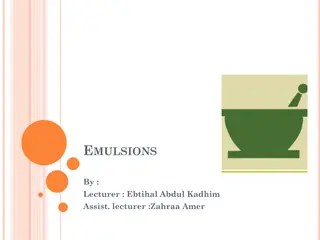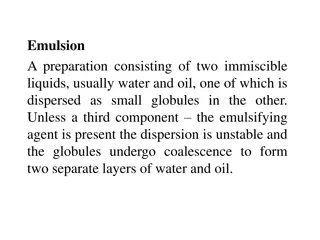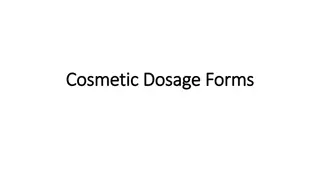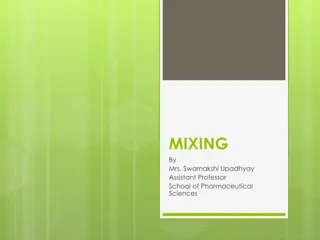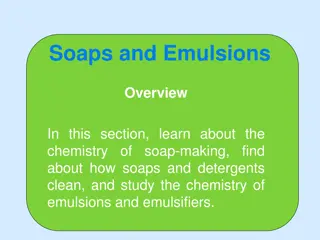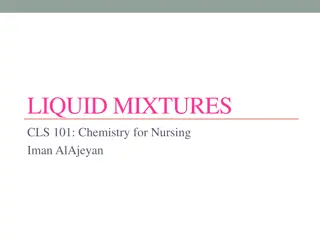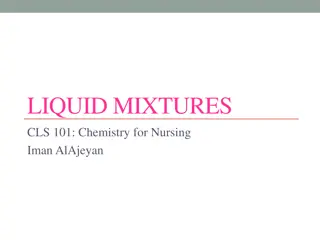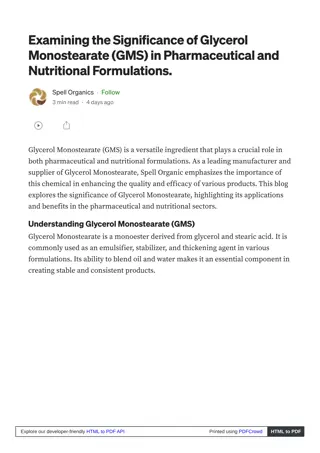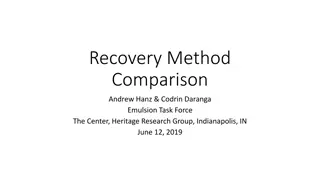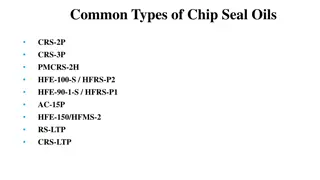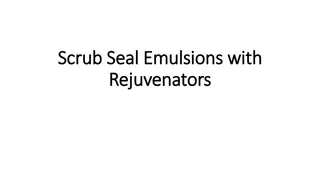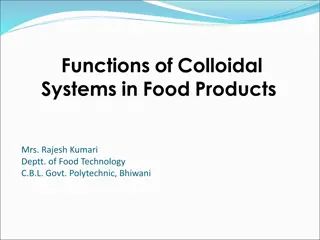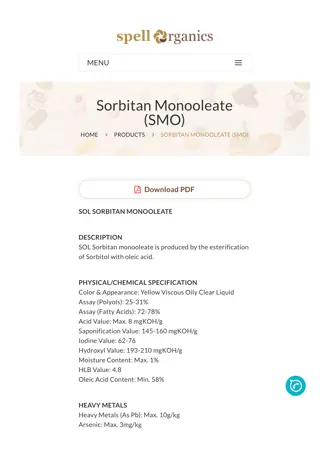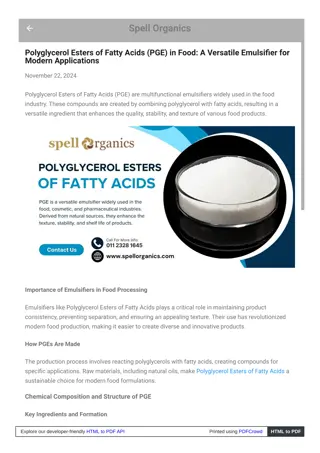Emulsions in Pharmaceuticals
Emulsions are dispersions where small liquid globules are distributed in an immiscible vehicle. While many pharmaceutical products are emulsions, some may fall into different categories. There are two main types of emulsions: oil dispersed in water (O/W) and water dispersed in oil (W/O). Factors aff
2 views • 33 slides
Emulsions: Types, Composition, and Stability
Emulsions are preparations of two immiscible liquids, such as water and oil, stabilized by an emulsifying agent. The composition of emulsions includes aqueous and oil phases, each with specific considerations for stability and effectiveness. Types of emulsions include oil-in-water and water-in-oil e
4 views • 90 slides
Cosmetic Dosage Forms in the Beauty Industry
Solutions, emulsions, and water-in-silicon formulations are essential cosmetic dosage forms with unique characteristics and applications. Solutions range from water-based to anhydrous, while emulsions offer versatility for delivering hydrophilic and hydrophobic ingredients. Water-in-silicon emulsion
2 views • 19 slides
Mixing Processes in Pharmaceutical Sciences
Mixing is a fundamental operation in pharmaceutical sciences, involving blending different substances to achieve uniformity. This process is crucial for various applications, such as chemical reactions, suspensions, and emulsions. The types of mixtures, factors affecting mixing efficiency, and diffe
0 views • 23 slides
Meat Processing Techniques and Procedures
This article discusses the processing of meat and meat products, including basic and advanced procedures such as comminution, emulsification, and curing. It delves into the importance of size reduction, emulsions, and stable meat emulsions in enhancing the quality and characteristics of meat product
0 views • 21 slides
The Chemistry of Soaps and Emulsions: An Overview
Explore the fascinating world of soap-making and emulsions' chemistry. Discover how soaps are formed through alkaline hydrolysis, the structure of soap molecules, and how they clean oily stains effectively. Learn about emulsions, emulsifiers, and the science behind soap production.
1 views • 24 slides
Waterproofing for Construction
Waterproofing is essential for preventing water leakage in structures like bathrooms, toilets, and terraces. It helps maintain a habitable environment, protect building components, and increase the building's lifespan. Causes of leaks include structural movement and temperature variations. Different
0 views • 6 slides
Colloids and Their Importance in Pharmaceuticals
Colloids play a vital role in the pharmaceutical industry as heterogeneous biphasic systems with particle sizes ranging from 1nm to 100nm. They are classified based on aggregation and interaction of phases, with examples like aerosols, foams, emulsions, and more. Colloids can be prepared by condensa
0 views • 23 slides
Liquid Mixtures in Nursing Chemistry
A comprehensive overview of liquid mixtures in nursing chemistry, including types of mixtures, properties of solutions and suspensions, and the distinction between homogeneous and heterogeneous mixtures. Explore the concepts of solutions, suspensions, colloids, and emulsions with clear explanations
7 views • 18 slides
Asphalt Binders in Pavement Construction
Asphalt binders play a crucial role in pavement construction, composed of three types of hydrocarbons: asphaltenes, resins, and oils. Different types of asphalt cements are produced for specific applications, such as liquid asphalts and asphalt emulsions. Quality control tests ensure the performance
0 views • 16 slides
Liquid Mixtures in Nursing Chemistry
Explore the world of liquid mixtures in nursing chemistry with a detailed look at solutions, suspensions, colloids, and emulsions. Learn about the properties of solutions and suspensions, the distinction between homogeneous and heterogeneous mixtures, and the various types of liquid mixtures encount
7 views • 18 slides
Liniments: Alcoholic and Oleaginous Solutions for External Application
Liniments are topical solutions intended for external application to the skin through rubbing. They can be alcoholic or oleaginous, with the choice of vehicle depending on the desired action and solubility of components. Emulsions require thorough shaking before use, and the solvent for oleaginous l
4 views • 5 slides
Emulsions: Types, Factors, Tests, and Requirements
Emulsions are dispersions of liquid globules in a medium where they are immiscible. Learn about oil-in-water and water-in-oil emulsions, factors affecting emulsion types, identification tests, and requirements for creating stable emulsions.
0 views • 28 slides
Understanding Sorbitan Monooleate: Applications and Benefits in Industry
Sorbitan Monooleate is a versatile emulsifier widely used across various industries, including cosmetics, food, and pharmaceuticals. Its ability to stabilize emulsions makes it essential in creating consistent and high-quality products. In the food i
0 views • 11 slides
Analysis of Recovery Methods for Emulsions in Asphalt Industry
This study compares the effectiveness of low temperature evaporation recovery methods in asphalt emulsions testing. The research evaluates different machines, film thicknesses, and recovery methods to understand their impact on the test results. Results show variability between labs and highlight th
0 views • 11 slides
Solubility, Polarity, and Cleaning in Chemistry
Explore the concepts of solubility in different solvents, the role of polarity in dissolving compounds, and how cleaning agents work based on their polar or nonpolar nature. Discover how soap molecules form micelles to remove stains effectively, and learn about emulsions like mayonnaise where oil an
0 views • 18 slides
Cosmetic Creams: Types and Formulations
Cosmetic creams come in various types such as cold cream, emollient cream, and beeswax-borax cream, each serving different purposes for skincare. These creams are formulated as white emulsions with specific ingredients like cetyl esters wax, white wax, and mineral oils. Cold creams provide nourishme
0 views • 22 slides
A Comprehensive Guide to Common Chip Seal Oils
Explore various types of chip seal oils used for road surfacing, including CRS-2P, CRS-3P, PMCRS-2H, HFE-100-S, HFRS-P2, AC-15P, HFE-150, RS-LTP, and more. Learn about their applications, compositions, and ideal usage conditions such as temperature requirements and traffic intensity. Discover hot ap
0 views • 4 slides
Enhancing Scrub Seal Emulsions for Asphalt Mix Rejuvenation
Activities of the Spray Group involve developing effective materials specifications for scrub seal emulsions with rejuvenators to properly rejuvenate cracked asphalt mixes. The purpose is to ensure successful applications with the most effective products. Consideration of elastic polymers, non-elast
0 views • 4 slides
Colloidal Systems in Food Products
Colloidal systems play a crucial role in providing structure, texture, and mouthfeel to various food products such as jam, ice cream, and mayonnaise. They are formed when one substance disperses through another without forming a solution, resulting in various types of colloids like gels, sols, emuls
0 views • 15 slides
Innovative Fluid Solutions for Textile and Leather Finishing
Specialty Fluids by Blue Star Silicone offer a comprehensive range of silicone-based products for textile and leather finishing. From softeners and water repellents to emulsions and lubricants, these solutions cater to the needs of formulators in the textile and leather industries. The Amino Fluids
0 views • 6 slides
Sorbitan Monooleate- Perfecting Food Emulsions and Cosmetic Creams
Sorbitan Monooleate (SMO) is a versatile emulsifier that plays a critical role in perfecting food emulsions and cosmetic creams. It ensures smooth textures and stable formulations by preventing ingredient separation and enhancing consistency. Whether
0 views • 5 slides
Polyglycerol Esters of Fatty Acids: Enhancing Quality Across Food Products
Polyglycerol Esters of Fatty Acids (PGE) are essential in improving the quality and consistency of various food products. These multifunctional emulsifiers enhance texture, stabilize emulsions, and prolong shelf life, making them vital for bakery, co
0 views • 4 slides
